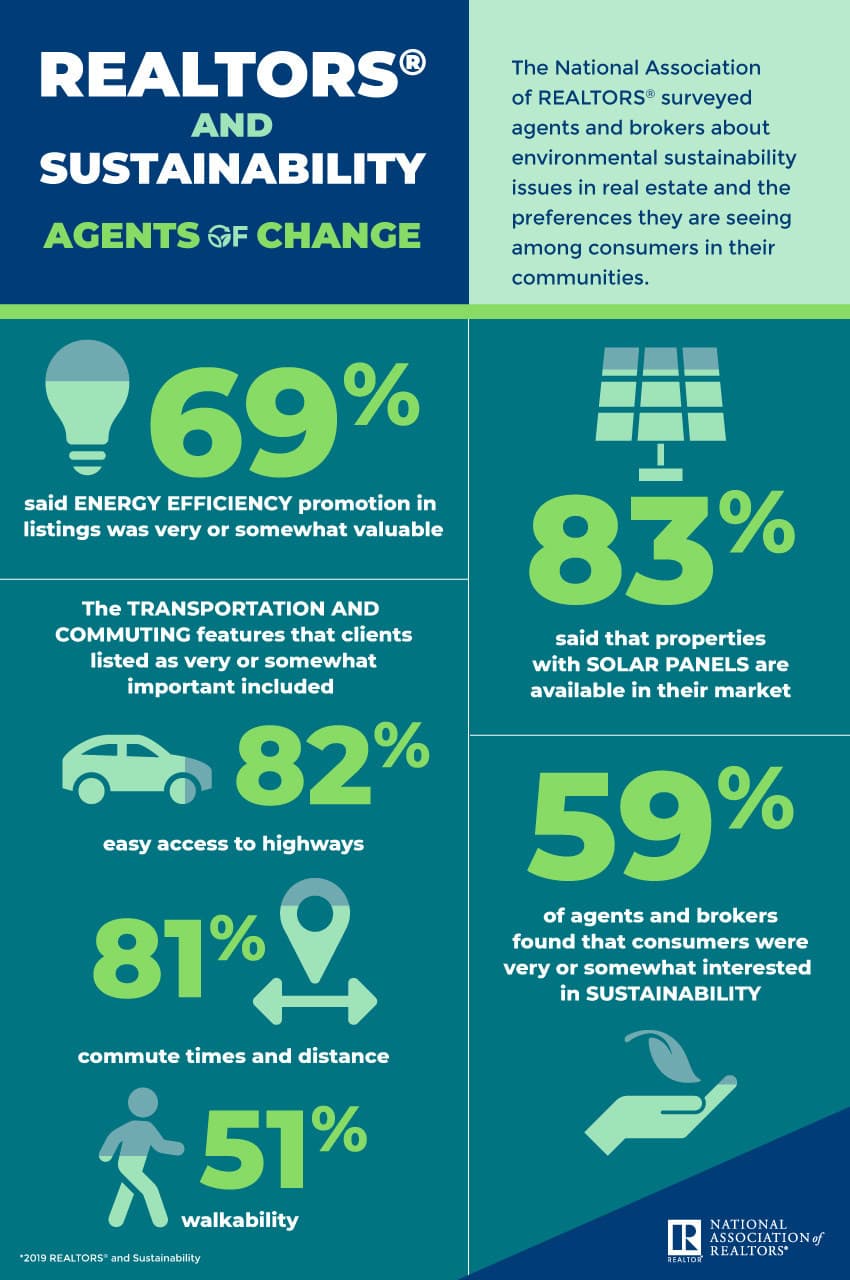As our Countdown to California 2020 continues — the year in which all new homes in California will be required to include solar energy — home buyers and Realtors across the country are reporting increased interest in homes with solar systems — and are willing to pay for it.
According to NAR’s REALTORS and Sustainability 2019 Report, consumer demand in real estate continues to trend eco-friendly. The report is in its third iteration and stems from NAR’s Sustainability Program. It surveyed Realtors about sustainability issues in the residential and commercial real estate markets and the preferences they are seeing in consumers in their communities. According to the report, 59 percent of respondents found that residential consumers were very or somewhat interested in sustainability. Seven in 10 residential and commercial agents and brokers reported that promoting energy efficiency in listings is either somewhat or very valuable.
“The state of the environment is important to our members and their business practices, and the report shows that sustainability impacts consumers’ home buying decisions as well,” said NAR President John Smaby, a second-generation Realtor from Edina, Minnesota and broker at Edina Realty. “Realtors remain on the cutting edge of sustainability and continue to lead the conversation about energy efficiency in real estate.”
The numbers aren’t overwhelming, but the trends are there.
- A large majority of respondents (83%) said that solar panels were available in their markets
- 36 percent said that solar panels increased the perceived property value.
- On the other hand, only 8 percent of those surveyed said that solar panels decreased the perceived amount of time a home spent on the market.
- Solar panels are most prevalent in Northeast (available in 94% of markets) and respondents in the West were the most likely to report they increase perceived property value (41%).
Forty-one percent of respondents were aware that their Multiple Listing Service, or MLS, has green data fields, compared to only 14% that were unaware. Among those that do have green data fields, 35% of respondents use them to promote green features, 26% use to promote energy information and 14% use to promote green certifications.
When asked what they consider as the top market issues and considerations regarding sustainability, agents and brokers named understanding lending options for energy upgrades or solar panels (38%), the lack of information and materials provided to real estate professionals (32%) and improving the energy efficiency of existing housing stock (31%).
Solar homes sell for more, says Zillow
During the past year, homes with solar-energy systems sold for 4.1% more on average than comparable homes without solar power, according to new research from online real estate marketplace Zillow. For the median-valued home, that translates to an additional $9,274.
The Zillow Group Consumer Housing Trends Report calculated the solar premium by comparing homes with and without solar-energy systems that were listed for sale and sold from March 1, 2018 to February 28, 2019, controlling for observable attributes of the homes, including bedrooms, bathrooms, square footage, age of the home and location.
The sale premium varies substantially by market. In Riverside, Calif., for example, homes with solar-energy systems sold for 2.7% more than comparable homes without solar power—a markup of $9,926 for the median-valued home in the metro. In the greater New York City metro, solar-powered homes have a premium that is double that of Riverside. At 5.4%, that’s an extra $23,989 in value for the typical home in New York. In three other coastal metro areas—Los Angeles, San Francisco and Orlando, Fla.—homes with solar power can fetch a premium of around 4%.
Zillow now has a “Sun Number” on more than 84 million homes nationwide, which measures the roof of each home and calculates the pitch, orientation and size of each roof plane. It determines the amount of sun that hits every square meter of the home’s roof, taking into account factors such as trees or taller buildings that could block sunlight. Finally, it adds local factors such as the cost of electricity and solar and the local weather conditions. The end result is a number between zero and 100; the higher the score, the more suitable for solar that house is.
Commercial influence
Respondents in NAR’s survey were also asked about sustainability in commercial real estate. Seventy percent of agents and brokers indicated that promoting energy efficiency in their commercial listings was very or somewhat valuable. Sixteen percent of respondents reported that their Commercial Information Exchange had green data fields and that those fields promote energy information and green features. The top building features that clients specified as very or somewhat important to their agents or brokers were utility/operation costs (81%), efficient use of lighting (67%) and indoor air quality (64%).
— Solar Builder magazine



Leave a Reply
You must be logged in to post a comment.